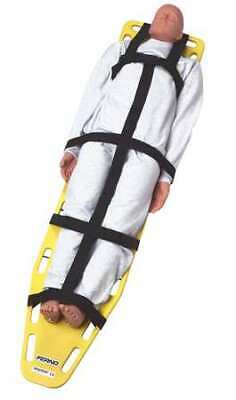-40%
Garaventa Evacu-Trac CD7 Emergency Evacuation Chair for disabled mobility
$ 792
- Description
- Size Guide
Description
Garaventa Evacu-Trac CD7 Emergency Evacuation Chair for disabled mobilityThis sale is for a Garaventa Evacu-Trac CD7 Emergency Evacuation Chair for disabled mobility
Condition:
Excellent condition, fully functional. Comes with wall mounted factory case.
Warranty:
30 Day Warranty.
We pledge to offer the best service and warranty to all of our customers! We are extending a 30 day warranty on this item. This is our way of saying thank you for allowing us to serve you.
Certification:
This is an genuine product from this manufacturer.
Web Information:
EvacuTrac - Evacuation Chair
Does your emergency evacuation plan include an evacuation chair for someone with a mobility-related disability? In the event of a fire or earthquake, elevators should not be used for the emergency evacuation of a building. In this situation, people with limited mobility may be trapped or have to wait for a prolonged period of time in an area of refuge.
Designed so that a small attendant can easily move a much larger passenger down the stairs, the Evacu-Trac is easily set up and ready for a passenger to transfer from their wheelchair to the comfortable sling seat. This evacuation chair has durable rubber tracks that firmly grip the stairs and the safety brake can stop the unit on the stairs if necessary. The Evacu-Trac is completely stable and self-supporting on flat surfaces and during descent.
Highlights:
The safest evacuation chair!
One person operation
Lower transfer height
Easy to operate
Speed Governor
Fast deployment
Low center of gravity
Operating the Evacu-Trac evacuation chair
The Evacu-Trac evacuation chair is normally kept in a storage cabinet located near the upper stair landing, ready for use in an emergency situation.
Remove the evacuation chair from the storage cabinet and place the unit on a flat surface. Grasp the handle and pull it up in a quick, smooth motion. This will lock the Evacu-Trac in the open position.
Transfer passenger from their wheelchair to the Evacu-Trac. Three Velcro straps are provided for securing the passenger. These straps help immobilize an injured person or help transport a person with no upper body control. The lower torso straps allows a younger passenger to be well secured while being transported in the
emergency stair chair.
The Evacu-Trac brake is normally on. To descend the stairs, release the brake by slowly squeezing the brake lever. Descent speed can be slowed by reducing pressure on this lever. A governor limits the maximum descent speed to about 3' per second, allowing even a small attendant to safely transport heavier riders.
It is recommended to use the inside of the stairway to allow room for other traffic and to make it easier to turn corners at stairway landings.
On stairs, the tracks securely grip the stair noses and control the descent speed regardless of the stair covering. On flat surfaces, the evacuation chair can be pushed on its wheels as easily as a stroller. This feature allows the user to be transported to an area clear of the emergency rather than to an area of refuge.
Once clear of the emergency area, park the evacuation chair on a flat surface and engage the brake by releasing the bar.
Evacu-Trac - Emergency Evacuation Plan
Do you have an emergency evacuation plan that meets the needs of everyone?
During an emergency such as a fire or earthquake, the law states elevators can't be used. This means that people with disabilities, or anyone who can't use the stairs may be trapped by the elevators that gave them access to the upper stories.
An evacuation plan should include everyone, not just those who are able bodied. Understanding an evacuation plan is crucial. Regular practice drills are part of emergency plan and provide a means of evacuation for everyone, including people who can not use the stairs by themselves.
An example evacuation plan:
The U.S. Access Board is an independent Federal Agency devoted to accessibility for people with disabilities. This site outlines their emergency evacuation plan that accommodates persons with disabilities. Click here to go to the U.S. Access Board's Evacuation Plan.
The Access Board has also provided some background information on how they designed their evacuation plan to meet the needs of their employees.



















